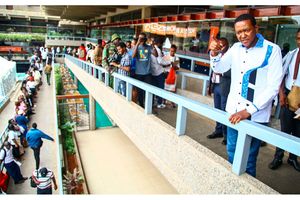
About 2.9 million Kenyans are jobless with those under 29 hardest hit.
President William Ruto’s one-million-jobs-a-year promise looks increasingly unlikely to be achieved as key projects he was banking on bump into challenges.
Medium-term expenditure framework report for the social protection, culture and recreation sector shows the government plans to create just 680,000 jobs over the four full years to June 2027 when the current administration's first term comes to an end.
This means there will be a shortfall of 3.32 million jobs over the four-year period compared to the four million jobs that the President promised.
The government is banking on affordable housing programme, jobs export and creation of ICT hubs in every ward to deliver on the jobs pledged but all the initiatives have experienced a slow start.
A target to place 140,000 job seekers in gainful employment during the year to June 2024 was missed, with just 108,338 persons (77 per cent) posted according to the State department for labour.
“Public employment services play an important role in linking jobseekers with employment opportunities and collecting labour market information for forecasting and evidence-based policy decision making,” the department notes in budget documents.
Under the programme on employment promotion services, the State department plans to place 160,000 job-seekers in gainful employment during the current fiscal year, which is expected to raise to 180,000 jobs in 2025/26, and 200,000 openings by the 2026/27 fiscal year.
With an underperformance that saw just 77 per cent of the targeted jobs created in the year to June 2024, the possibility that the State will achieve the total of 680,000 jobs target in four years dims further.
The government also plans to place 97,000 graduates in internships during the four years to June 2027, though only 19 out of the targeted 15,000 were posted during the 2023/24 fiscal year.
The State Department notes that the public employment service in Kenya has lagged in terms of capacity, technology and methodologies for linking jobseekers with employment opportunities in the labour market.
This gave birth to a plan by Kenya’s National Employment Authority to build a National Employment Promotion Centre to be used as a one stop shop for all job services.
Promise
The government’s housing programme, the primary job-creation mechanism that was expected to deliver a million jobs every year has, however, disappointed with less than 5,000 houses constructed since President Ruto came to power, out of a promised 500,000 houses.
The government’s jobs export policy also appears to be struggling with labour department documents revealing a poor performance on the export of Kenyan migrant workers.
Out of the 233,000 migrant workers the state department targeted to provide with pre-departure training during the year to June 2024, only 35,947 (15 percent) were trained, documents show.
Over the four years to June 2027, the state department plans to train a total of 413,000 for departure to work as migrant workers abroad, but should the performance be as low as the previous fiscal year’s the achievement could be about 60,000 Kenyans.
In the Kenya Kwanza manifesto ahead of August 2022 elections, President Ruto had pointed to the potential of Kenya’s leather industry to create 100,000 jobs overtime, among other sectors that he promised to invest in.
“The Kenya Kwanza housing commitment is to turn the housing challenge into an economic opportunity. Next to agriculture, we see housing production as the sector that will create quality jobs for the 100,000 or so young people that are graduating from TVETs every year directly in the construction sector and indirectly through the production of building products,” the manifesto stated.









